Profile
Blog
Photos
Videos
25.Ethiopia - 9 January to 31 January 2010
Ethiopia has been our greatest surprise so far, certainly not the desert and famine that tends to be associated with the country. The vast majority of Ethiopians live on an elevated, very fertile central plateau called the Ethiopian or Abyssinian Highlands, and the landscape is truly spectacular, further enhanced by the Great Rift Valley. And definitely a bonus - the date is May 2002 on the Ethiopian calendar, and suddenly we're younger by nearly eight years!
After crossing the remote border post from Kenya, our Ethiopian experience started with our journey through the Omo Valley, which was both exciting yet daunting. We drove through dry riverbeds and occasional villages of domed huts, with children running out of nowhere, grabbing the cars wherever they could and running along while trying to hold on. Sometimes the older girls and boys would stand in the middle of the road waving arms to try and make us stop, so we had to edge carefully through them. Some children even threw stones and there were occasional displays of aggression - a woman shooing us away and a boy wielding a 'woko' or herding stick at us as we drove past. A little daunting, however, in contrast others waved excitedly and welcomed us with huge smiles. As we travelled further north, we still experienced a mixed reception, but we became accustomed to it, and it certainly didn't detract from our wonderful Ethiopian experience.
Exciting in the Omo Valley was the feeling of remoteness, and the people in traditional tribal dress. Initially we were encountering women and children wearing masses of beads around their necks, and little else, the women also wearing arm bands and decorative beading around their waists with scarring often on their backs or sides. The men with their goats or cattle carried their herding sticks and beautifully carved, wooden head-rests, similar to the 'pillows' of the Himba people in Namibia, but more decorative.
Closer to Turmi, we were predominantly seeing the Hamer tribe, and the women now with thick plaits of ochre-coloured hair with long fringes, and wearing dangling skirts of leather skins decorated with masses of cowrie shells, and a dozen or more copper bracelets fixed tightly around their arms. Many of the men were also highly decorated with charcoal and ash rubbed into their skin, feathers on their heads and collars of beads around their necks like the women. And it was on the road to Turmi that we saw our first sign written in Arabic.
Our first two nights in Ethiopia were spent at Mango Camp in Turmi, beautifully shaded with huge mango trees on the bank of a creek. Before we left we visited the market which was also a fascinating experience, with so many people in traditional dress walking to town pulling goats, or carrying huge loads of grass or hay, or charcoal, and all manner of implements and produce for the market. Not far out of Turmi on our way to Jinka we came across a local car axle-deep in sand in one of the dry riverbeds, and we managed to winch it out, with plenty of interested local onlookers and passers-by. Towards Jinka we started climbing out of the lowlands, but the road was basically a side-track the whole way, with roadworks that appeared to have been in progress for many years. On one occasion, young boys from perhaps the Karo tribe were beside the road, their bodies rubbed with charcoal, walking on tall stilts trying to attract our attention.
We camped at Jinka Resort which was quite pleasant with a good bar/restaurant, and tasted our first Ethiopian beer - one of the three different brands. From Jinka we travelled to Arba Minch where we stayed in reasonably priced rooms at Paradise Lodge, high up in the mountains, arriving too late to set up camp. The restaurant and deck had a magnificent view of Lake Chamo and Lake Abaya, a perfect spot for sundowners, and here we had our first taste of traditional Ethiopian food, including injera, a sponge-like bread with a similar texture to pancakes but with quite a bitter taste - great as an accompaniment to the traditional meat dishes.
Between Arba Minch and Addis Ababa, we had a night camping on Lake Langano after a long day's drive through isolated villages, where the locals yell out "You, you, you" and chase the car, wanting you to stop and give them something or anything. It becomes quite a moral dilemma, as we have so much and they have so little, and yet no amount of giving will change their situation, and if anything probably exacerbates the gap.
An interesting drive to Addis Ababa and the road became more and more busy and hectic as we got closer to the city. Huge numbers of donkey or horse-driven carts, often crowded with people, or else donkeys overladen with produce, their little legs buckling under the weight. The first couple of nights in Addis we camped at Wim's Holland House, which was a challenge with dogs barking most of the night, and rather than the 'Call to Prayer' early in the mornings to which we have become quite accustomed as we've travelled through countries with predominantly Muslim populations, now in Ethiopia which is predominantly Christian Orthodox, the priests start their chanting before daylight and continue for at least a couple of hours. We were in Addis for Epiphany, an important religious event on the Ethiopian calendar, with a holiday to mark its significance, which may have accounted for the length of these early morning calls. Wim's was a friendly place with a great restaurant where the traditional food was excellent. On our first night we were lucky enough to chat to some of the locals who had called in to the restaurant after a wedding for a few drinks, and were very friendly. But after a couple of nights, we opted for another hotel stay, firstly at Jupiters, and then at the Intercontinental, which was a nice break from camping.
Addis is a typical bustling, overwhelming African city, but fascinating! Men walk hand in hand or with their arms draped around each other, a culturally acceptable way of engaging in conversation as they walk down the street; coffee houses everywhere, supporting a very traditional coffee culture; the usual crazy traffic to negotiate; and countless noisy building sites adding to the dust and chaos - with shoe-shiners in the streets doing a roaring trade with the locals!We find Africa is full of stark contrasts, one of which was a visit to the Sheraton Hotel - the serenity and plush surroundings are truly an 'out of Africa' experience - but great coffee and cakes and good internet connection!
While in Addis we submitted a visa application at the Libyan Embassy which we hope to pick up in Alexandria, and we also visited the National Museum to view the famous remains of 'Lucy', one of the oldest finds of human-like remains for which the Rift Valley is famous. They also had a really interesting 1 minute or 60 second time line: one minute represents the time that has passed since the most ancient human lived - 4 million, 400,000 years ago - so 1 second = 73, 333 years. This means that on the 16th second, Lucy was born, lived and died; on the 26th second, the first real man appeared; only around the 54th second was fire mastered by man who didn't look like modern man until the 57th second. And the invention of writing, the construction of pyramids, and the events of the 20th century, all these events that make History, they passed in a tiny fraction of the 60th and last second. Wow!!
Leaving Addis Ababa we climbed to an even greater elevation of around 3000 metres. Ethiopia is deliciously cool due to the elevation of the highlands, in fact we have been amazed how cool it has been in all the countries so close to the equator due to elevation, apart from our Christmas on the coast in Kenya which was very hot. The Western clothing worn in Addis immediately changed to the more traditional, and the scenery was immediately spectacular, with rich fertile soil, and the countryside looking very productive, with people harvesting crops on their knees by hand with scythes into bundles, which were then beaten on the ground to dislodge the grain, and then carried to be thrown onto one of many haystacks dotted across the landscape. Everything seemed so well managed - even the cattle looked in good order - and the towns and villages were neat and tidy without the usual rubbish and plastic bags in the street. We were also interested to see the huge numbers of eucalyptus trees growing everywhere - felt like home. They use them for so many different purposes - for firewood, for the framework of houses before filling the gaps with mud, and the leafy branches for fences. Donkeys and people carry huge loads of eucalypts branches which are cut at ground level, and then grow again in thin branches.
Our destination was Lalibela, high up in the Ethiopian highlands, and famous for its rock-hewn churches carved out of the red limestone. It was worth the two day drive. Our first day revealed the most spectacular scenery so far as we wound our way down through the 1km deep Blue Nile River Gorge, and up the other side. We spent two nights in 'interesting' hotels at Mota and Debre Tabor, and as breakfast wasn't included in the tariffs, two self-catered 'carpark' breakfasts provided some entertainment for the locals. On the second day we had a wonderful lunch at a resort in Bahir Dar on the edge of Lake Tana, which is the source of the Blue Nile.
We spent a day touring the eleven rock-hewn churches - absolutely fascinating - and we camped at Mountain View Hotel in Lalibela, perched on the edge of a mountain overlooking more spectacular mountains as far as you could see in a 180 degree view. Sunsets from the roof of the hotel were spectacular and a perfect spot for a sundowner.
From Lalibela we travelled to Gondar, where we visited the Royal Enclosure which consists of a walled compound of 17th Century castles and buildings built by Emperor Fasilada. We stayed at the Goha Hotel, once more opting for a room rather than camping. The hotel once again was perched high above the town, with a great view, and on our last night in Ethiopia we were lucky enough to witness the lively celebrations of an Ethiopian wedding in the grounds of the hotel - great fun.
- comments





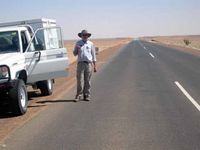
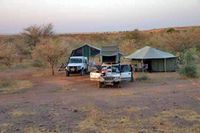
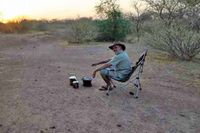
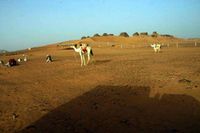
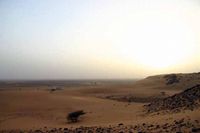
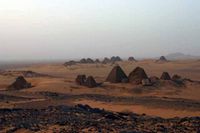
mem Moz and Brian, you are amazing, your desciptions so alive and full of adventure,makes our lives so beige...stay safe and enjoy the ride.Loads of love from us all.x